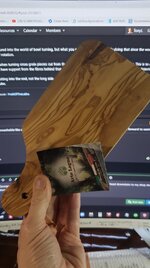Hi Tony,
You probably would prefer that I don't comment on anything Olivewood related from your initial comments I could see that you were trying to prevent any comments involving the origin of the wood and quite honestly I don't think you need to be worried about me spitting the dummy and taking the issue in a totally different direction than intended, I have as you and many know, very CLEAR views regarding anything thing Olive wood, regardless if Bow, Italian, Australian and any other country origin but your question has nothing to do with the wood origin, in a way I thought that you only like to work with Bow but is nothing wrong with Italian Olive wood, in fact, most of the artifacts/utensils on sale made of Olive wood all around the world come from Italy and I have to say, I've seen some stunning Italian Olive wood matching the best I ever got my hand into.
Regarding your question and despite the fact that you already said that you had your question answered, I would like to add a few bits more of info that you may find helpful or maybe not, either way, others may appreciate the info.
In my pen blanks processing years, I have almost tried every single wood species I represent/sell cut in cross cut including Olive wood and I found that it's workability, strength and stability depend upon a few factors, one of which is crucial to a pen blank size cut in such way and that is, how oily the wood is and from where the blank was cut from. The most fragile on Olive wood or in the majority of wood species cut that way is when the blank was cut from a fairly small diameter log/limb (up to 6") and the middle of the blank touches the pith line, most of those blanks will snap fairly easily at the point where the grains go in different directions, if you know what I mean, however, I have also to say that most of the best looking cross cut blanks are cut that way, something that I do deliberately in most of my cross cut blanks.
I don't know the size of this Italian Olive board you got nor the wood grain it contains, a pic would help significantly, hopefully, the board has wide grain making it less fragile to cross cut. Other members have mentioned some ways to prepare the blank for turning, from removing corners to sanding, etc., those actions sure will help prevent snapping but there is also one other area that many folks trying to turn a pen from a cross cut blanks have problems with is with the drilling where the blanks breaks apart from the drill bit pressure, I suggest that some preparation before drilling will remove the risk of destroying the blank and for that, I suggest that the blank is supported from the 4 sides with some sacrificial pieces of wood, plywood or other firm material glued for strength, others may consider using tape and wrap the blank around with it but in my experience, even the strongest of tapes will alow some movement if the drill grabs the wood, if not looking cracked that may be deceiving and hairline cracks on a cross cut blank will almost certainly result in a blown-up blank when on the lathe unless the tube glue-up was done with a strong glue supporting the wood all around the tube and the glue is dry/set.
I have also often suggested the use of the "flap disk" for fragile cross cut blanks but many folks don't like or think that procedure should not be used for wood turning, I'm not here to discuss if I agree with them or not but I and many others that tried this system can guarantee great success.
Looking forward to seeing what you endup with.
Best of luck,
Cheers
George

